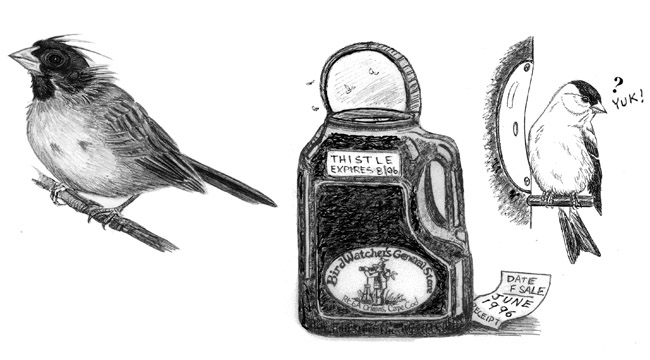
It’s mid-summer,
And man, it’s hot. It’s too hot to spend my usual fifty hours doing research at Harvard University’s Widener Library, looking for the answer to another earth-shattering question, like which bird is on the Puerto Rican commemorative stamp. So instead, I’m going to write a column made up entirely of questions I have answered in the past. Some of these questions I’ve answered a few times before and some a gazillion times before, or more. Hopefully, doing this will help anyone who has somehow missed those past columns. Plus, it will keep me from having to make the long, hot drive to Harvard University’s Widener Library…wherever that is.
The past few weeks I’ve had a handful of people wondering why they aren’t getting goldfinches on their feeders. It’s hard for me to imagine that anyone would have trouble getting goldfinches in the summer. Finches may be the most abundant feeder this time of year. While most other birds are feeding insects to their fledglings, the vegetarian goldfinches are staying true to their principles and eating nothing but seeds. In fact, in August we sell more thistle and sunflower hearts (the finches’ two favorite foods) than we do in any other month of the year. So why are some people not getting finches? Well, after cross-examination, it turns out that nearly every one of these “no-finch” people are using thistle seed that they’ve had left over from last year. What? Using year-old seed? This isn’t Twinkies we are talking about. Thistle has a shelf life. After a few months it dries out and becomes unattractive to finches. So if you are having trouble getting goldfinches, try cleaning out your feeder and then go buy some fresh thistle. This should take care of your no-finch problem. Remember, thistle seed doesn’t get better with age. That only applies to wine, antiques and Twinkies.
Speaking of old seed, this next item is a drum that I’ve been banging for the past thirty years and yet it still seems to fall on deaf ears. In the summer birdseed has a big problem with meal moths. Heat causes the moth eggs, which are already in the seed, to hatch. When that happens the seed becomes buggy and webby, and I get phone calls. Storing seed in airtight containers won’t stop the moth eggs from hatching. The only way to prevent trouble is to buy small amounts of seed and use it up in a few weeks, before the eggs have a chance to hatch. Yesterday a lady called me because the seed she bought in early June had become buggy in August. I said, “Yup, that’s what happens.” Buying birdseed today and then keeping it around for some point in the future is not a wise thing to do. That plan might work with savings bonds, but not so much with birdseed.
Here’s an August favorite. Why is my cardinal bald? Seeing a cardinal without its crest really freaks some people out. They are convinced it’s a sign of the apocalypse. But all birds, even cardinals, need to change their clothes at least once in a while. Most molt all of their feathers after the breeding season. Sometimes a bird molts so slowly that we can barely tell that any change is taking place. Other times the molt is rapid and feathers fall out before the new ones have a chance to grow back in. In this case the bird looks a little blotchy, like it had a real bad day at Supercuts. For some reason cardinals (and Blue Jays, too) seem to lose their head feathers more rapidly than other birds. And when this happens the famous crest is gone, exposing the black head underneath and making the bird look bald. Not to worry, the head feathers will grow back and the bird will look normal soon enough. There is no need to run out and buy your cardinal a baseball cap to protect it from the sun or mix Rogaine in your birdseed.
Here’s a common question that is a bit sexist, so I’m almost afraid to answer it. Why do I only have dull female hummingbirds at my feeder? Where are the handsome males? I want to go on record as saying that both male and female birds are equally attractive. (There, that should keep the protesters away for a while.) The reason why we see more female hummers is because there are simply more females to see, perhaps as many as ten percent more. Why more females? When it comes to raising a family it’s the female hummers that do all the work, so it would make sense that nature would make more of them. In addition, all the young hummers look just like their mothers. New male Ruby-throated Hummingbirds won’t become “ruby-throated” until next spring. In August, a young male only has a few flecks of red on his neck, looking like he cut himself shaving or has a slight case of teenage acne.
This last question is music to my ears. Why are so many birds eating at my feeders right now? I’m going to write it again, just to put a smile on my face. Why are so many birds eating at my feeders right now? The answer is simple. Adult birds have just finished cranking out tons of babies and thus we now have two, three or four times as many birds around as we did earlier in the year. August is a very active month at bird feeders, with all the baby birds demanding lots and lots of expensive birdseed. August is a birdseed retailers dream month. This increased activity lasts until late fall, when many of the birds push south. Then the question switches from “Why so many birds…” to, “What happened to all the birds?” And that’s the end of the smile on my face…until next August.